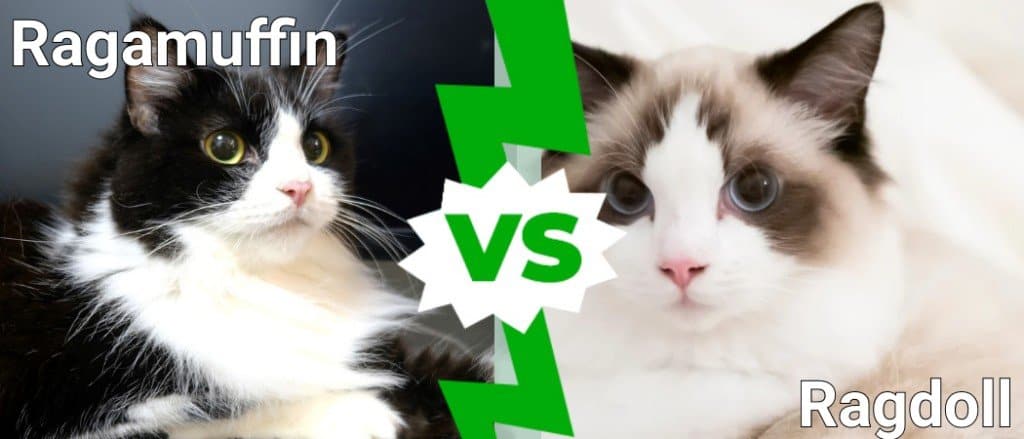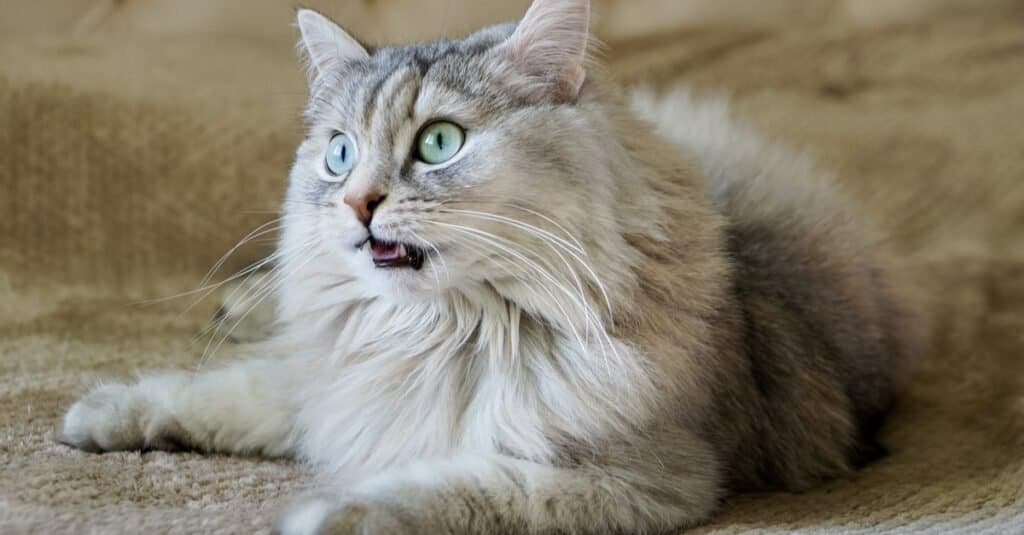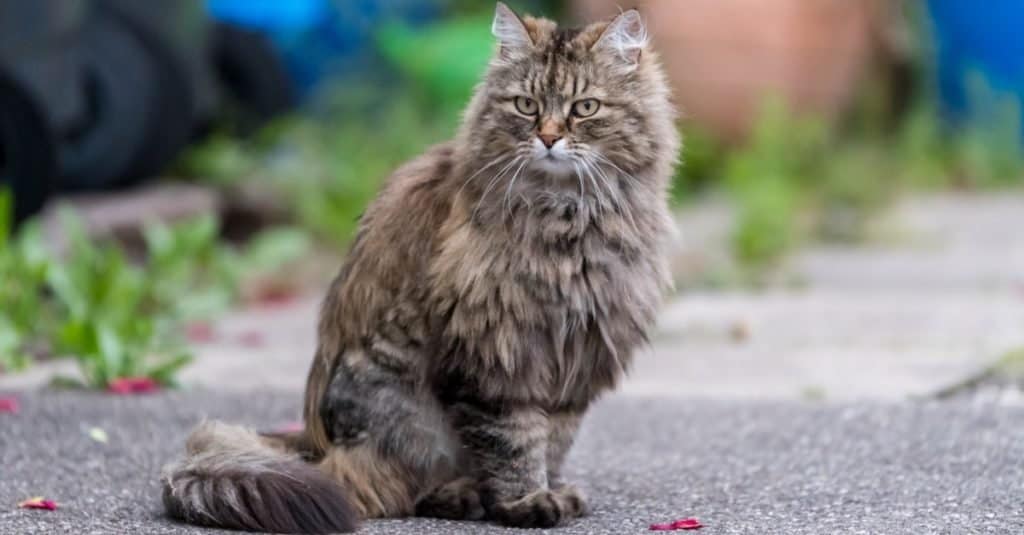Many people confuse Ragamuffin and Ragdoll cats, and it’s understandable why: they are both large, fluffy, and affectionate cats. These sweet-natured felines can weigh up to 15 pounds and have a similar appearance. It can be quite a chore to tell them apart if you don’t look closely. However, the Cat Fancier’s Association considers them two separate and distinct breeds. The most noticeable difference is in the color of their coats, with Ragamuffins boasting more variations than Ragdolls. Although they may appear to be very similar, there are a few differences that may affect your decision when it comes to picking the “purrfect” pet for you. Let’s explore the significant characteristics that differentiate the two cats below.
Comparing a Ragamuffin and a Ragdoll

| Ragamuffin | Ragdoll | |
| Coats | – wide variety of colors | – distinct point coloration |
| Eyes | – varies in color and rounded | – vivid blue and oval-shaped |
| Personality | – patient around children- welcoming to change in lifestyle and routine | – laid-back around family members- highly affectionate to owner |
| Grooming and Care | – groom once a week- hygienic habits like brushing teeth and wiping eyes | – groom twice a week- daily brushing to avoid tangles |
| Training | – eager to learn | – independent and unbothered |
The 5 Key Differences Between a Ragamuffin and a Ragdoll
The main differences between a Ragamuffin and a Ragdoll include their coats, eyes, personality, grooming, and attitude when training. Neither of these breeds’ development was naturally occurring. Ragdolls were created in the 1960s by a California cat breeder. However, there is no documented history of the Ragamuffin’s evolution. They’re both stunning cats with super temperaments, making them great family pets. Both are large breeds with a lifespan of up to 17 years.
Although the two breeds are related, each has its own set of advantages and disadvantages that any potential owner should be aware of before bringing one home. Below, we will take an in-depth look at their differences.
Ragamuffin vs Ragdoll: Coats

Ragamuffins have a broader range of coats.
©Trusova Evgeniya/Shutterstock.com
While both breeds have the same long coat and a plumed tail, Ragamuffins are more resistant to matting. They also have a broader range of coats, including a lot of white, but they don’t have the point type coloration. Their coats are available in a large spectrum of solid and patterned hues, ranging from orange and chocolate to black and lilac.
Ragdolls are naturally born white. Their coats change color as they grow, becoming chocolate, blue, lilac, or seal. They also have “points” comparable to Siamese cats’ markings. Point coloration indicates that the Ragdoll’s legs, paws, ears, face, and tail are darker in color than the rest of its body. Ragdolls, however, can still have white “boots” or “gloves” on their paws.
Ragamuffin vs Ragdoll: Eyes

Ragamuffins have a variety of eye colors while Ragdolls have vivid blue eyes.
©iStock.com/Julia Gomina
Although both breeds have stunning, big eyes, there is a distinct contrast between them. Ragamuffin cats can have a variety of eye colors and a more rounded appearance, comparable to that of a walnut. For many years, people mistook them for Ragdolls. These cats were classified as a separate breed in 1994, with an enormous physique, a broad chest, and a short neck.
One of the revealing signs of a Ragdoll cat is their extraordinarily gorgeous, vivid blue eyes. Blue eyes are present in every purebred Ragdoll cat. They are not purebred if their eyes are of a different color. Their eyes are oval-shaped, comparable to almonds, and softer to look at than Ragamuffins’.
Ragamuffin vs Ragdoll: Personality

Ragdolls are not as laid-back as Ragamuffins.
©Benjamin B/Shutterstock.com
When it comes to personality, both breeds are known for being incredibly gentle and docile, so you can’t go wrong if you want to adopt one as a pet. However, the Ragamuffin is the preferred pet for families with young children because of its peaceful and patient demeanor. Apart from its charming features, the Ragamuffin stands out in the feline world because it is open to any change in its lifestyle and routine. It genuinely and easily welcomes any new addition to the family, whether a new baby or a new pet.
Ragdolls are also laid-back, although not nearly as relaxed as Ragamuffins around children. But don’t get them wrong, these cats make excellent emotional support animals because they are in tune with their owners’ mental states. If you’re depressed or anxious, your Ragdoll will come running to comfort you in a matter of seconds. “Floppy” is one of the most commonly used adjectives to characterize them, and they are lap cats, so don’t be surprised if your personal space is no longer yours. Ragdolls aren’t afraid to demand affection, and, like Ragamuffins, they will frequently greet you at the door when you return home.
Ragamuffin vs Ragdoll: Grooming and Care
Ragamuffins’ long, silky coats are tangle-resistant, so brushing them every day is not necessary. Grooming once a week is typically sufficient. Regardless, they won’t shed much. Brush their teeth, trim their nails, and clean their ears regularly. Because they are susceptible to eye infections, wipe any discharge from their eyes with a clean, damp cloth.
Ragdolls require twice as much grooming as Ragamuffins because their fur can become matted and tangled. As a result, you should brush them at least once a day if you can. Most Ragdolls, on the other hand, prefer being caressed, so this can be a beneficial bonding experience.
Ragamuffin vs Ragdoll: Training
Most people doubt that we can teach a cat to do anything, yet Ragamuffins are eager to learn new skills. When training, never use harsh punishments. While these cats are friendly and calm, they have strong memories, so any mistreatment will surely resurface in the future.
Although you can teach your Ragdoll a few tricks, this cat is mostly independent. Ragdolls march to the beat of their own drum, and while they will consider your expectations, they don’t feel obligated to make you happy.
Take things slow and always employ positive reinforcement during training. These breeds will respond well to praise and affection alone, but treats are a great addition to the mix. They are prone to fat, though, so don’t go overboard.
The photo featured at the top of this post is © Peredniankina/Shutterstock.com
Thank you for reading! Have some feedback for us? Contact the AZ Animals editorial team.






